Helminths are subcutaneous parasites that live in the human body. They feed on the cells of the host, releasing toxic substances. Infection with parasites can lead to serious illness and, in the worst case, death. Depending on the type of worms, their location varies. Some multiply in the organs, others live under human skin, provoking the development of dermatoses.
Types of subcutaneous parasites and modes of infection
Parasitic skin diseases are not common diseases. Nevertheless, cases of illness have been reported. It probably happened after visiting Asian regions and countries with hot climates. Parasites in the human body cause an allergic reaction accompanied by unbearable itching.
In medicine, worms are divided into two types:
- Subcutaneous. Hem samples are difficult to diagnose. After infection and the maturing stage, the parasites pass through the human body. The most common types of subcutaneous helminths are iron, scabies mites, filariae, rishta.
- Skin. After contact with human skin, parasites migrate to different parts of the body. Infection of the skin parasites results in inflammation of the pancreas, scaly lichen, eczema and diabetes.
Common cases include an infection caused by a tick localized in the sebaceous glands. It is characterized by the fact that it exits the surface of the epidermis during the day to nourish the secretions from the skin ducts.
Filariasis
Filariasis is the defeat of a person by nematode-type parasites. It is found in countries in the Asian region as well as in places with tropical climates. The most likely way to get infected is to visit recreation areas. The main threat to parasites is the long incubation period. Without symptoms, worms can live under the skin for 5-7 years. Pests are distinguished by excessive vital activity, which causes symptoms of intoxication in the patient.
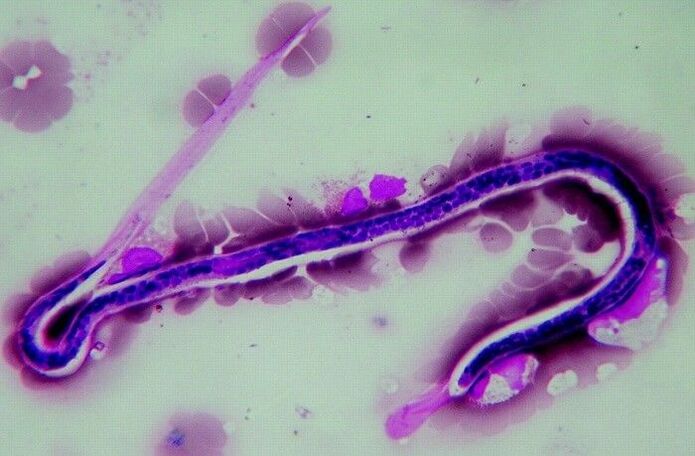
There are signs of a hives in the early stages of the disease. As the worms grow and multiply, they lose vision, develop mobile seals, and develop fever. In later stages, the location of the worms is determined with the naked eye.
Dracunculiasis
Dracunculiasis is a disease caused by infection of subcutaneous helminths. They are able to live in open water. Human infection occurs during travel when raw water from an uncontrolled source is consumed. In an infected person, the larvae are located below the upper layer of the epidermis. The presence of another parasite leads to death without proper treatment. In the world practice, 100-centimeter-long adult helminth samples were registered. They can occupy the entire space of the stomach, liver, or block the airways.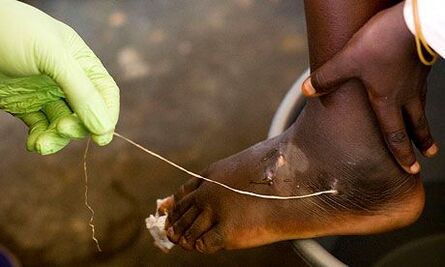 Most commonly, helminths are localized in the lower extremities.
Most commonly, helminths are localized in the lower extremities.
The main symptoms of the injury are:
- rashes on the legs;
- formation of fluid-filled blisters;
- unbearable itching;
- appearance of bumps;
- purulent formations.
The main treatment is the surgical removal of the helminth from the body.
Schistosomiasis
The disease provokes several types of helminths that are found in water bodies. The infection occurs during swimming in rivers and lakes in the African and Asian region. Another mode of infection is untested drinking water. It is the source of the spread of the eggs and larvae of the parasites. Initially, helminths are localized below the epidermis. An allergic rash develops on the skin, accompanied by itching. As the disease develops, the larvae penetrate deep into the body. The patient's kidneys and liver are severely affected. The disease is accompanied by night fever and heavy sweating. Enlarged liver and deformed kidneys may help diagnose the infection.
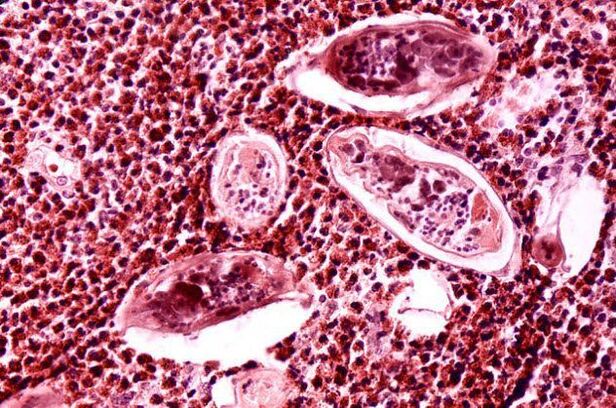
Cysticercosis
Cysticercosis is a disease associated with human infection with the porcine tapeworm. The parasite belongs to the hardy category and lives in Asian countries. The penetration of 1 larval or worm part is sufficient for the development of an adult in the human body. Parasites are highly regenerative, making the treatment process difficult.
The main signs of damage are hives, itching, general weakness, pain. Worms are often localized under the skin, in the muscles, in the eyes, in the internal organs, and in the brain. During the development of adults, tuberculosis or induration develops under the skin. It can grow over time, bringing inconvenience. The main breeding grounds for swine tapeworms are the shoulders, chest, arms and palms.
Dirofilaria
The main mode of infection by worms is the penetration of larvae by insect bites or contact with animals. Temporary carriers of larvae act as carriers of cats and dogs, mosquitoes. The female worm is 30 centimeters long and the male 10 centimeters long.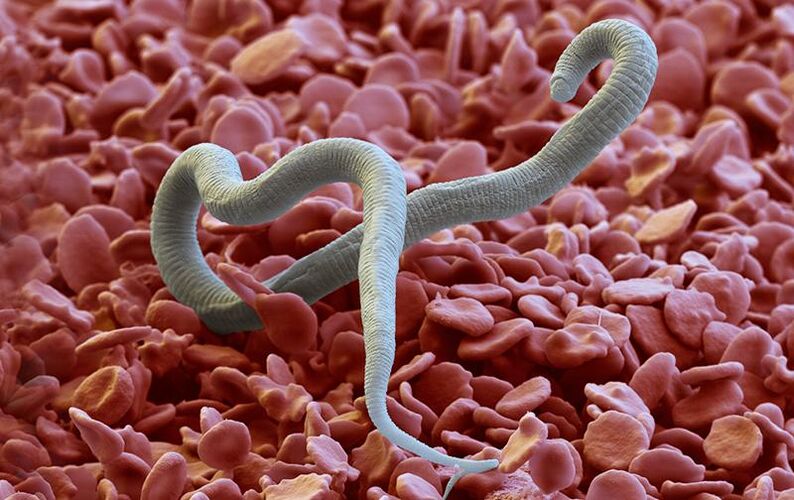 Parasites develop below the upper layer of the epidermis.
Parasites develop below the upper layer of the epidermis.
The egg remains on human skin when mosquito bites. The hatched larvae penetrate deep into the skin through the damaged area of the skin. It goes through all the stages of becoming an adult there. The disease is accompanied by intolerable itching. Seals are detected in the area where the worms are located. The patient feels the movement of the adults under the skin. Loss of vision is possible if affected by helminths.
The worms are treated operatively. After surgery, patients are shown medications that restore the skin and affected organs.
Scabies
Scabies is an infection of a person who has a scabies mite. The disease was named after a strong, unbearable itching all over the body. In places where ticks are localized, people show redness and blemishes.
A tick infection occurs during physical contact with an infected person or personal items. Diagnosis is made by visual examination of the skin and laboratory tests.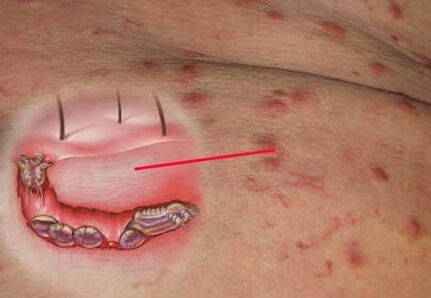 At home, diagnostics can be performed with iodine. When it comes in contact with the affected skin, a cobweb becomes noticeable - the path of ticks moving under the skin of the infected person.
At home, diagnostics can be performed with iodine. When it comes in contact with the affected skin, a cobweb becomes noticeable - the path of ticks moving under the skin of the infected person.
The main symptoms of scabies are:
- itching and redness;
- formation of fluid-filled blisters when scratching the skin;
- localization of lesions of the hand and joints.
Treating the disease is long and laborious. Complete removal of parasites is almost impossible.
Demodecosis
Demodic scabies is a human infection caused by ticks under the skin. They are localized in the sebaceous glands of the infected. In the initial stages, the disease can be easily confused with acne. As the mites multiply, the rashes increase and spread all over the face. The loss of lashes begins.
The diagnosis of demodicosis is simple. To do this, a visual examination is performed and a number of laboratory tests are performed. The treatment of the disease is long-term. In some cases, this can take several years. A tick infection occurs through direct contact with the patient, using the infected person's personal items or cosmetic products. The unstable hormonal background, the weakened immune system, promotes the successful reproduction of ticks.
Symptoms of the disease
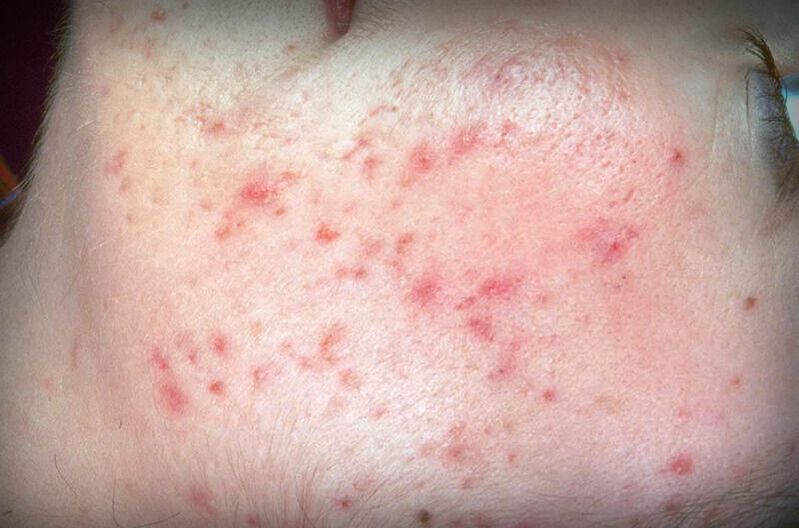
Modern medicine distinguishes between several subcutaneous parasites. They cause dermatitis of the skin and disturbance of the internal organs. Depending on the pathogen in the individual, the symptoms appear in a specific way. However, there are a number of symptoms that it is recommended to consult a specialist.
There are several signs you can learn about worms in your body:
- general weakness;
- temperature rise to 39 ° C;
- itching of the skin of varying intensity;
- appearance of skin rashes;
- overturned gastrointestinal tract;
- formation of seals on the skin.
It is important to note that an early visit to the doctor will allow you to get rid of parasites living under the human skin quickly.
Diagnostic features
In humans, subcutaneous parasites are difficult to diagnose. Therefore, if the lesion is first suspected, a specialist should be consulted. The complexity of the diagnosis is directly related to the latent course of the disease. Basically, vivid symptoms only appear a few years after defeat, which negatively affects health.

Several symptoms suggest intestinal worm invasion, but there is no general clinical picture of the manifestation. The defeat of a patient with intestinal worms should be ruled out in the case of reddening of the skin areas, the appearance of constant itching, and various seals on the skin.
Visiting a number of professionals will allow you to make the right diagnosis:
- dermatologist;
- neuropathologist;
- allergist;
- infectious disease specialist;
- psychologist.
A psychologist will be consulted if no divergence is found towards other professionals.
To clarify the diagnosis, patients are provided with laboratory tests:
- blood test for antigens;
- skin sample testing;
- anointed;
- secret research;
- scraping from the affected area.
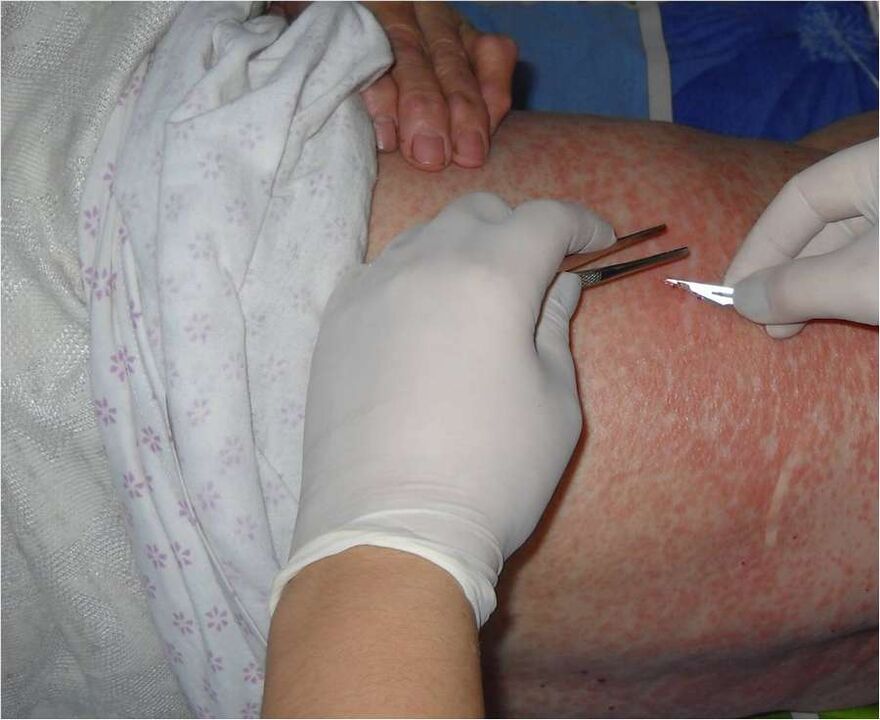
The results of laboratory tests may detect parasites under the skin. If you have traveled to Asian countries or other tropical regions in the last six months before the onset of symptoms, this fact should be reported to your doctor.
Diagnosis of subcutaneous parasites requires the designation of a competent therapeutic regimen. In this situation, the use of drugs or traditional methods of treatment that are not recommended by your doctor is prohibited. Violation of the therapeutic regimen can lead to deterioration and poisoning of the body.
Effective treatments
In medical practice, there are two methods for treating parasites: pharmacological and surgical. Depending on the complexity of the lesion, your doctor will use one method or a combination of both. The choice of therapeutic treatment methods depends on the patient's health risk and the characteristics of the parasites.

The choice of method of therapy is influenced by:
- the number of parasites in the patient's body;
- the ability of the worm to regenerate;
- reproduction rate;
- localization of parasites;
- allergic reactions of the patient;
- the severity of the disease;
- possible or existing complications.
Drug treatment includes medication. The effects of the drugs are multi-directional exposures:
- Killing of developed worms and larvae in the body, preventing their reproduction. Anthelmintics are used for this.
- Removal of inflammation and destruction of foci of infection. For this, antibiotic therapy is performed.
- Accelerate the removal of toxins and the removal of allergic reactions. The patient is prescribed antihistamines and glucocorticoid drugs.
- Healing of the affected areas of the skin. Creams and ointments are used to accelerate the regenerative function of the epidermis.
In case of severe complications and special location of the worm, surgical treatment of subcutaneous parasites is recommended. Surgery has been shown to be highly effective in cases where the body is known to affect only one person. Surgery is most commonly used for dracunculiasis. The internal fluid of the worm contains toxic substances that can cause anaphylactic shock. In this case, a holistic extraction of the parasite is seen.
Prevention methods
Infection of human skin parasites requires long-term therapy. There are a number of preventative measures you can take to avoid this problem:
- Compliance with hygiene rules. Wash hands under running water with soap or antiseptic. Especially after contact with unknown or stray animals. Scratches, cuts and other skin damage should be treated with antiseptics.
- Product processing. Fresh vegetables and fruits should be rinsed thoroughly under running water before use. It is recommended to heat the fish, poultry and meat. Avoid consuming raw or semi-raw meat.
- Use of proven water sources. Water from unknown sources should be treated. Open water bodies and springs deserve special attention.
- Routine vaccination. Before traveling to tropical countries, you need to be vaccinated against major diseases.
- General use of makeup. Women should avoid sharing makeup, even with close friends.
- Swimming in open water. Swimming in contaminated or untested bodies is prohibited. In the hot season, preference should be given to water bodies that have been tested for water quality.
Taking a responsible approach to our own health and adhering to preventative measures will help prevent parasitic skin diseases.
























